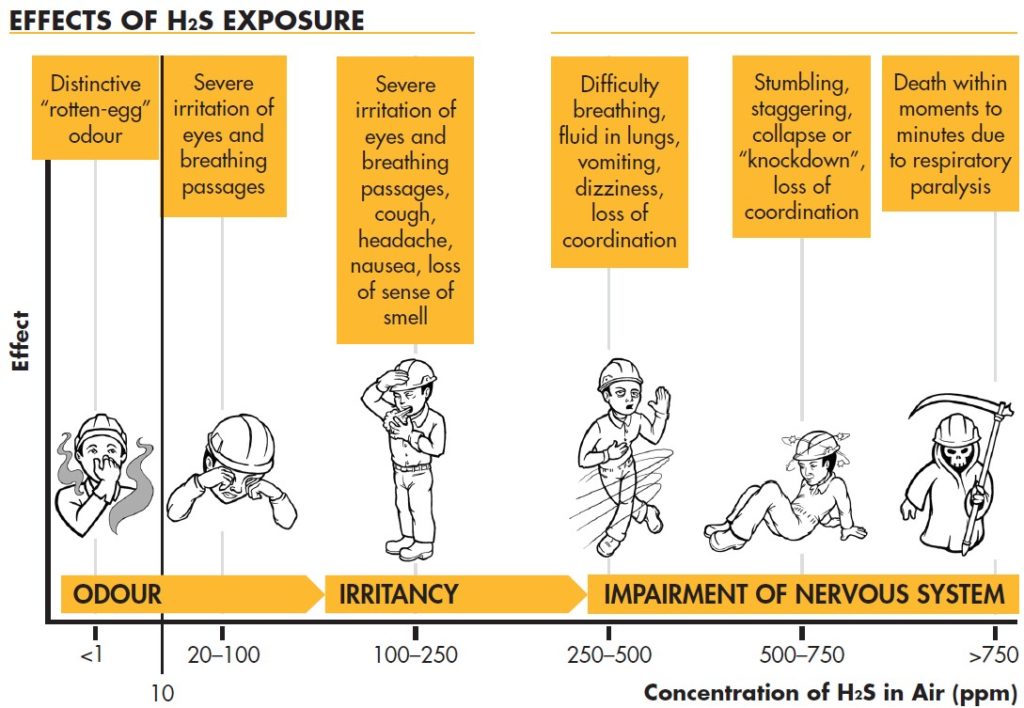Hydrogen Sulphide detected in a bilge tank
During routine transfer of bilge water from engine room bilge wells to the bilge water tank, the crew noticed the smell of “rotten eggs” from the bilge tank vent. Immediately the transfer was stopped. During measuring the vent pipe with the Dräger multi-gas meter it was confirmed 453 ppm of H2S (Hydrogen Sulphide) was detected.
Preventive actions were taken to ensure the gasses did not enter the accommodation. The quick response of the vessel crew prevented a serious accident.

The immediate hazard was of a dangerous or even lethal atmosphere (High H2S concentration). Seawater in (bilge) tanks, especially in the engine room, mixed with various residues and biodegradable detergents are a perfect place for the development of dangerous levels of H2S. Failure to recognize the dangers could have resulted in explosion, intoxication or even loss of life.
What went wrong?
- Technical
- Bilge tank had not been dealt with or emptied for a longer period – it had not filled up;
- Regular inspection of the tank was not easily possible;
- Several corners of the tank had built up (stone) residue, which was not easily removed.
- Organizational
- Lack of knowledge: during the communication with external parties it was found that some parties were uncertain how to handle the removal of the sludge from the tank without contaminating the atmosphere of the surrounding ER spaces;
- The on-location specialist was occupied and not able to assist immediately;
- There was not a suitable berth available for tank cleaning;
- The required vacuum and ventilation equipment were not available and there was a delay of some days before the final removal of sludge and tank cleaning.
Actions taken
- Stopped the transfer (“Stop the Job”);
- Measured the H2S concentration;
- Informed emergency response team and client;
- Connected flexible hose to vent pipe to route gasses away from the accommodation;
- Requested assistance from local agencies on removal of the bilge residue and tank cleaning;
- Constant monitoring by measuring device with crew in full respiratory protection;
- Removal of Bilge water and cleaning of the tank by a specialized company;
- Gas free certificate issued.
Lessons learned
- Review of vessel machinery cleaning practice;
- Clean machinery spaces with detergents when the ship is in port, preferably using fresh water
- Check if use of bio-degradable detergents are necessary or possibility for replacement additives and cleaning agents
Members may wish to refer to:
- H2S, the killer – booklet from the government of Alberta [other similar information from other governments is available]
- H₂S leak umbilical laying
Safety Event
Published: 25 November 2021
Download: IMCA SF 32/21
IMCA Safety Flashes
Submit a Report
IMCA Safety Flashes summarise key safety matters and incidents, allowing lessons to be more easily learnt for the benefit of all. The effectiveness of the IMCA Safety Flash system depends on Members sharing information and so avoiding repeat incidents. Please consider adding [email protected] to your internal distribution list for safety alerts or manually submitting information on incidents you consider may be relevant. All information is anonymised or sanitised, as appropriate.
IMCA’s store terms and conditions (https://www.imca-int.com/legal-notices/terms/) apply to all downloads from IMCA’s website, including this document.
IMCA makes every effort to ensure the accuracy and reliability of the data contained in the documents it publishes, but IMCA shall not be liable for any guidance and/or recommendation and/or statement herein contained. The information contained in this document does not fulfil or replace any individual’s or Member's legal, regulatory or other duties or obligations in respect of their operations. Individuals and Members remain solely responsible for the safe, lawful and proper conduct of their operations.
